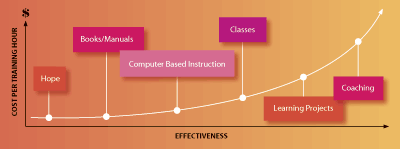A recent study by Bersin and Associates, a leading talent management research firm, found that organizations that had a strong learning culture had the following characteristics:
- 37% greater employee productivity
- 32% more likely to be first to market with products/services
- 17% more likely to be market leaders.
Most organizations would be thrilled to have these advantages, and so the question becomes, “What is a learning culture?” The Bersin and Associates study examined organizations on many dimensions, but fundamentally, there are two key components of a learning culture:
- The company knows what skills, knowledge and competencies are needed by their employees to be successful.
- They are committed to providing employees with opportunity to continuously learn and upgrade their skills.
Change, competitive pressure and growth are some of the forces that affect your business, and in turn, your employees. New employees need to be trained, new managers need to learn how to supervise effectively, and experienced managers need to learn how to deal with an increasingly complex business environment. In addition to these forces, research shows that when talented employees are not offered opportunities to learn and grow, they leave.
Knowledge and skills can be effectively developed through a variety of techniques. Attitudes can gradually be changed through feedback and reinforcement, but they are both difficult and slow to change. Creating “new” or “different” attitudes is usually the result of sustained organization and cultural change that impacts many, not just a single employee. My belief is you hire the right attitude—and you develop the rest.
There are many different tools and strategies you can use to increase an employee’s knowledge and skills, and in turn, impact performance. The tools and strategies you can use have expense attached to them (both time and money), and like most things in life, you get what you pay for. Typically, but not always, effectiveness is directly related to cost. This very simple diagram illustrates that concept:

The left axis reflects “Cost per training hour.” This includes not only possible fees, but the cost of designing or structuring training, the cost of time spent training, the loss of productivity not only of the employee, but others assisting in the learning process. The bottom axis reflects “Effectiveness.” I define effectiveness as the probability the learner will be able to immediately apply new knowledge/skills at a reasonably competent level in order to achieve business objectives. That’s the point after all, isn’t it?
I want to address the first “technique” on the curve in this article; and that’s the development strategy called “Hope.” This is where you “hope” an employee learns what they need to learn and develops the skills they need to be a high performer. This is sort of like throwing someone in the deep end of the pool and thinking they’ll learn to swim. They’ll learn to survive (you hope), but without training, they’ll never win a swimming contest. The Hope technique is deceptively inexpensive. No dollars are flowing to the training expense line, but you’re not reaping the rewards of a trained, skilled, engaged, creative, professional, high-performing employee, either. Doing nothing is a decision to not actively develop the capabilities of your employees. One of my favorite quotes is: “If you think training is expensive, try ignorance.”
Traditional training is NOT, however, the one and only, best answer to increasing your employees’ knowledge and skills. The key to effectively developing an employee’s skills and increasing his or her performance is to carefully match the need with the appropriate development strategy. Adult learning research has shown that most people acquire 70 percent of their skills and knowledge through direct experience, 20 percent by observing someone, and only 10 percent in a formal training environment. While direct experience may be perceived as throwing someone in to the deep end of the pool, it actually means that the learner’s experience is highly structured and designed for learning, and as they try new behaviors or skills, they receive immediate feedback and corrective guidance. But as the graph shows, designing and implementing learning projects is time- and resource-intensive.
Building a highly skilled workforce requires that a company has a detailed and in-depth understanding of the skills and behaviors that create success in their organization. Secondly, the company must have the ability to assess employee skill accurately, and thirdly, it must be able to select the appropriate development technique for the situation. Most importantly, managers and leaders throughout the organization must expect training to make a difference and hold employees accountable for improved
performance. iBi
Marvis Meyers is the vice president of training and development at
AAIM Employers' Association.

